The Chinese New Year, also known as Lunar New Year, is the most important festival in China: it lasts up to two weeks. Food plays a big part in this family gathering holiday period. The festive and different kinds of food people eat during this special period are meant to bring families together and symbolize a great new year.
So what is considered lucky food for Chinese New Year (This link brings you to the article: 9 Traditional Food Dishes for Chinese New Year)? Here is a guide on the top 10 lucky foods for the Chinese New Year Feast and their symbolic meanings, which are based on their pronunciations or appearance. Many traditional foods are served because their names are homophones for words such as luck and wealth in Cantonese and other Chinese dialects.
1. Chinese Dumplings — Wealth

With a history of more than 1,800 years, dumplings are the most well-known Chinese dish in China and other countries in the world. According to ancient legend, the more dumplings you eat during the New Year celebrations, the more money you can make in the upcoming Year. Because of the shape, dumplings have a royal name during the Chinese New Year – yuán bǎo (the gold ingot in Ancient China), which was the currency in Ancient China and it represented wealth.
Almost every Chinese people have seen or made dumplings themselves. Some make the dumpling wrappers themselves by mixing the dough and making it into round wrappers with a rolling pin. This does take up a lot of time, but it is also when the fun begins. It looks like a production line where some family members prepare the wrappers while others fill the wrappers with stuffing and make them into shapes. If you want to skip the wrapper-making process, you can easily find the dumpling wrapper in Asian grocery stores. Dumplings should be arranged in lines instead of circles, because circles are supposed to mean one’s life will go round in circles, never going anywhere.
Dumplings generally consist of minced meat and finely-chopped vegetables wrapped in a thin dough skin. Popular fillings include minced pork, shrimp chicken, beef, lamb, and different kinds of vegetables. They can be cooked by boiling, steaming, or pan-fried. The possibility of dumpling filling is endless. But not all of them are created equal. In fact, some dumplings are forbidden. Dumplings with sauerkraut are forbidden because they mean a poor and difficult future. Dumplings with cabbage and radish are a symbol of prosperity both for the body and the mind. Chinese people believe that cabbage and radish can bring one’s fair skin and calm mood.
In some areas, people put a white thread or a silver coin inside a dumpling. The person who eats that dumpling is said to possess longevity. If you want to make it extra fun for kids, include something small, brightly-colored, and edible, such as a goji berry or a pomegranate seed in a handful of dumplings as you wrap them.
2. Spring Rolls — Wealth

Spring rolls have a long history in China. It is said that the pastry appeared way back in the Eastern Jin Dynasty, between 266 to 420 A.D., when people would make thin cakes with flour and eat them with vegetables on the day of the Beginning of Spring. The cakes were called “spring dishes” at that time. It was sent to relatives and friends as a spring present and blessing.
It’s a Cantonese dim sum dish of cylindrical-shaped rolls filled with vegetables, meat, or something sweet. It’s believed to bring wealth to people because its shape looks like a gold bar.
Fillings are wrapped in thin dough wrappers, then fried, when the spring rolls are given their golden-yellow color. You can stuff these deep-fried rolls with various fillings, including pork, bean sprouts, shredded carrots, cabbage, and assorted other veggies. Spring rolls get their name because they are traditionally eaten during the Spring Festival. It is a Chinese New Year dish especially popular in East China: Jiangxi, Jiangsu, Shanghai, Fujian, Guangzhou, Shenzhen, Hong Kong, etc.
There are a few simple steps to make these spring rolls. First, knead the dough made of white flour, a little water, and salt. Then bake it into round wrappers. Add the filling inside the wrapper, roll them up and fold the two ends up. Lastly, deep-fry until they are golden brown and crispy. The size of spring rolls in China is generally smaller compared to those served in Chinese restaurants in America, which sometimes can be as big as hamburgers.
There are many local variations to spring rolls as China is so big. The people of Chengdu in Sichuan Province steam spring rolls. They use chili powder and paprika, processed sesame seeds, and crushed peanuts are added as seasonings.
3. Glutinous Rice Cake (Year Cake) — a Higher Income or Position
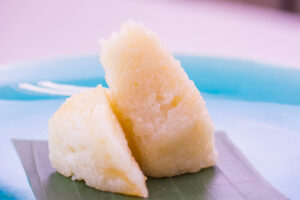
The name literally translates as “year cake” or in Mandarin “Nian Gao”. Because the first word “nian” means year, the second word “gao” also sounds like the word “higher” in Chinese, it was thought to be a lucky food to help you achieve a higher status or prosperity.
It’s a very simple steamed cake with a mochi-like chewy texture and sweetened with brown sugar. Year cake can be enjoyed all year round. Many people like it simply because they love the chewy texture. It can be easily found in Asian grocery stores, but you can also make it at home. It only requires 3 ingredients and the process is very straightforward. The best part is you can control the ingredients. If you are not a big fan of super sweet cakes, you are in control.
Year cake is made of glutinous rice flour, dark brown sugar, and water. After steaming the batter for an hour, the cake is soft and chewy. It’s hard to cut at this point. What you can do is to wrap it in plastic wrap and place it in the fridge overnight. This will make the cake hard and dense. When you take it out, you can slice it into the desired shape and either pan fry or deep fry until the cake is soft and chewy again. You can make these ahead of time, store them in the fridge, and gift them to friends.
Nian Gao can look slightly different depending on the region. In some regions of China, nian gao refers to white unsweetened rice cakes that are sliced and stir-fried into a savory dish, also called “Shanghai Nian Gao” in English. In Guangdong Province, people make something similar to Shanghai nian gao during Lunar New Year, but it’s called “Yin Nian Yuan”(“welcoming [new] year dumplings”). It’s often served warm as it is. However, in Hong Kong, people like to have the sliced year cake pan-fried with egg. If it’s pan-fried without egg, the texture would be slightly crispy outside and still pasty inside. The rice cake is usually served with some other snacks, like turnip cake and taro cake.
4. Sweet Rice Balls – Family Togetherness
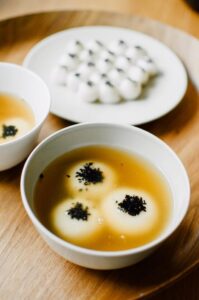
Traditionally, Chinese New Year lasts 15 days. On the last day of this festive period, it’s the Lantern Festival (or Yuan Xiao Jie). Hundreds of well-lit lanterns of all sizes, shapes, and colors fill houses, streets, and alleyways. Streets are filled with people watching dragon dancers and enjoying street foods. This is a special day for a family reunion when the family has a delightful dessert called Tang Yuan or Yuan Xiao (Chinese glutinous rice balls). Tang Yuan is served on this special day because the round rice balls symbolize harmony and togetherness, and the silky skin symbolizes everything will smoothly in the coming new year. However, tang yuan is not only reserved for the Lantern Festive. It is simply too delicious to eat once a year.
As a popular snack all over China, sweet rice balls are filled with red beans, sesame, peanut, and other sweet fillings. It’s kind of like round dumplings. The dumpling skins owe their pleasantly gummy texture to glutinous rice flour, which produces a chewier dough. With an interesting texture and a super tasty flavor, Tang Yuan can also be a Chinese sweet treat. It’s pure joy to eat freshly cooked Tang Yuan. After you bite through the slippery, chewy wrapper, the sweet, nutty, and runny filling slowly fills your mouth.
The dough for tang yuan is a simple combination of glutinous rice flour, regular rice flour, and water. Preparing the nuts is simple – just roast them, chop them up, and grind them in a mortar and pestle before mixing with lard and sugar. Tangyuan is first cooked in boiling water. Once cooked, the savory tangyuan is served in a clear soup broth. So you can have a soothing sweet soup in less than 5 minutes. The best part of making tang yuan at home is the endless choice of fillings you can add to these rice balls.
One thing to note though, since sticky rice flour is gluten-free, you may feel it is harder to control than normal flour. It leads to cracks on the surface or broken skins of the balls. We can surely soften the flour and make it more obedient by adding warmer water. Using hot water can make the dough super soft and thus easy to assemble.
5. Longevity Noodles — Happiness and Longevity
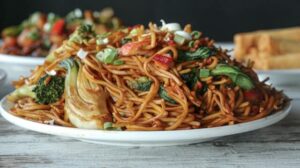
No Chinese New Year celebration would be complete without noodles. Longevity noodles symbolize longevity and can always be found at birthday and Chinese New Year celebrations. In addition to symbolizing longevity, eating noodles also signifies prosperity and good luck.
Longecity noodles are never cut or broken by the cook, and if they can be eaten without biting through the strands, it’s considered even more auspicious. Longevity noodles are usually stir-fried, presenting challenges to the home cook. They are tossed with garlic, mushrooms, and green onions for a super satisfying dish. Mushrooms naturally grow rapidly and symbolize prosperity. Eating green vegetables like watercress is important because the green represents wealth in the year ahead. The noodles are seasoned with soy sauce, oyster, sesame oil, and white pepper.
The type of noodle here is called Yi Mein. It has a unique texture and taste. It’s bouncy, chewy, and slightly spongy (in the best possible way). The noodles soak up sauce just right. Yi Mein can be also deep-fried before they are dried, which gives them a unique and slightly spongy texture.
Yi Mein goes by several names including:
- Yi Mein
- Yee Mein
- E-Fu Noodles
- Longevity Noodles
- Long Life Noodles
You can find them at most Chinese markets alongside other dried noodles. Yi mein is sold already deep-fried. So if you are planning to make it at home, boiling the noodles first helps remove excess oil. To cook with yi mein, toss the boiled noodles with the other ingredients and sauce. They pair well with almost any protein.
6. Good Fortune Fruit — Fullness and Wealth
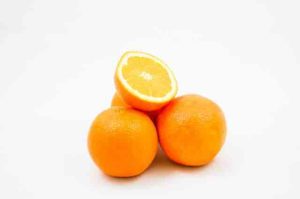
During the Chinese New Year period, certain fruits are selected as they are particularly round and “golden” in color, symbolizing fullness and wealth. And for the round shape, it’s an auspicious symbol of togetherness and harmony.
Eating and displaying tangerines, kumquats (Jinju), oranges, and pomelo is believed to bring good luck and fortune due to their pronunciation. In Chinese, orange (and tangerine) is 橙 (chéng), which sounds the same as the Chinese for “success”. Even in writing, it has good meaning too. One of the ways of writing tangerine (桔 jú ), the same meaning as 橙 (chéng), contains the Chinese character for luck (吉 jí). Eating pomelos is believed to bring continuous prosperity. The Chinese for pomelo (柚 yòu ) sounds like “to have” (有 yǒu), except for the tone, but exactly like ‘again’ (又 yòu). So the more you eat, the more wealth it will bring.
These fruits can also be given as part of a fruit basket and intended for eating over the festive period, usually at the end of the meal. The thin-skinned kumquats are pleasantly sweet, with a slight tartness but no bitterness, and are eaten whole, skin included. Giant pomelos, on the other hand, are hard work to get into but are a marvelous reward when finished. Some Chinese people will buy a pot of kumquat tree and place it at home, by this way, good fortune will come around the house. Kumquat trees adorned with red lai see Fong (literally, good fortune envelopes) are auspicious decorations at the start of the Lunar New Year.
7. Eight Treasure Rice
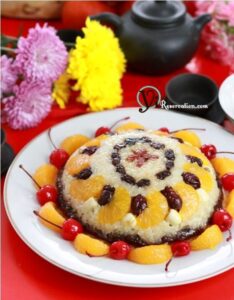
The wonderful origin of Eight-Treasure Rice traces back to the Western Zhou Dynasty in ancient China. That’s over 2000 years in making history! Traditionally, Eight Treasure Rice uses eight different toppings, A.K.A. eight treasures. It’s a dessert made from sweetened sticky rice, similar to Mango Sticky Rice, but topped with dried fruits and seeds. Eight Treasure Pie is commonly served during Chinese New Year and other Chinese festivals. According to Chinese medicine, eight ingredients are meant to provide a therapeutic effect.
Eight treasure rice pudding consists of three components: glutinous rice, toppings, and a filling. Glutinous Rice (Nuo Mi), also known as sticky rice or sweet rice, is a type of rice popular in Asian cuisine that, when cooked, delivers a sticky texture and a subtly sweet, aromatic taste. Dried Fruits and Nuts are used as toppings. These commonly include Jujube (Chinese date), golden raisins, dried cranberries, dried pear, peanuts, walnuts, and pumpkin seeds. Together with red bean paste (the filling), they make up “eight treasures”.
But if you make it at home, feel free to choose any nuts and seeds you like. Other popular options include dried apricot, goji berries, candied orange peel, dried kiwi, lotus seeds, almonds, cashew, pistachio, etc. Making this dish only requires 3 steps – soak the rice, assemble the bowl, and steam. Eight treasure rice pudding freezes well so you can prepare it in advance for meals on special occasions. Defrost it overnight in the fridge, unwrap and place on a plate. Steam for 10 minutes or so to reheat.
8. Prosperity Cake
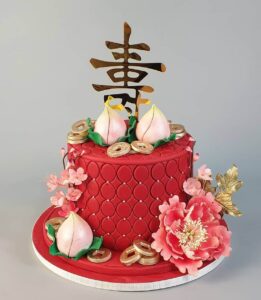
Prosperity cake, also referred to as Fa Gao, Lucky Cake, or Fortune Cake. It is often made and eaten during the Chinese New Year to bring prosperity in the new year. The name “fa” means prosperity, so fa gao literally means prosperity cake. It’s a play on words because the word “Fat” means both wealth and expansion- which is exactly what these cakes do when steamed. They expand and nearly explode out of their little cups!
Fa Gao is traditionally made with sticky rice as the main material, and now people replace sticky rice with flour. Depending on the different materials, the shapes and tastes of the cakes vary. Prosperity cake is very similar to cupcakes or muffins, but it is steamed instead of baked. The main ingredients used are normally rice flour, yeast, sugar, and bright colorful food coloring. Traditionally, the most common colors are white or pink and sometimes brown (from palm sugar added).
Because the cake is made mainly of rice flour, it’s quite dense and has an almost gummy-like texture. It is typically steamed on high heat until the top of the cake splits into 4 sections, like a “smile”. So fa gao is also often referred to as Chinese smiling steamed cake or even blooming flowers. They resemble full bloom flowers that are full of hopes and a bright future. Chinese people also believe that the more petals have blossomed, the more prosperous and wealthy they will be in the New Year.
9. Tray of Togetherness

The Tray of Togetherness also referred to as the Chinese New Year Candy Box, has been a part of Chinese New Year celebrations for centuries. It is a platter of sweets families traditionally used to welcome visiting guests during the Lunar New Year celebration. The general notion is that offering guests these sweet nibbles wishes them a sweet life in the year ahead. Each individual treats inside the tray has its own special symbolic meaning, conveying additional hopes for prosperity, longevity, and the like.
The tray, usually round or octagonal, holds the separate compartments snugly. Each tray or box usually has six or eight compartments. In Chinese, the number six symbolizes luck, and eight symbolizes fortune. The compartments are filled with candies, dried fruits, nuts, and other bite-sized treats. The list of sweet treats varies between regions and personal preferences, but generally, they all bring luck in their own strange ways. If you pick lotus root seeds, you’ll be blessed with many children, while melon seeds, you’ll be granted wealth and happiness. Nuts mean a long life with strong family ties. Coconut brings happy friendships and unity. Candied melon indicates good health and growth.
10. Fish – an Increase in Prosperity

Fish is one of the most important dishes on the Chinese New Year dinner menu. In Chinese, “fish” (Yú ) sounds like “surplus”. Chinese people always like to have a surplus at the end of the year. They think if they can save some at the end of the year, the next year they will be able to save more and make more as well.
Steamed fish is the most common one. Based on auspicious homophonic, Chinese people like to eat crucian carp(jìyú), Chinese mud carp(lǐyú), and catfish (niányú ). Let me explain. The first character of crucian carp sounds like a Chinese word that means “good luck. So eating crucian carp is meant to bring good luck for the next year. The first character of Chinese mud carp sounds like the word for gifts. So eating mud carp symbolizes a good relationship and fortune. The Chinese for “catfish” sounds like the word meaning “year plus”. So eating catfish is a wish for a surplus in the new year.
Chinese people eat one fish on New Year’s Eve and one on New Year’s Day to symbolize a surplus year after year. The fish should be the last dish on the menu and should not be eaten completely, as this has auspicious homophonous for there be surpluses every year. There are also some rules on how to position the fish. The head should be placed toward distinguished guests or elders, representing respect. Diners can enjoy the fish only after the one who faces the fish head eats first. The fish shouldn’t be moved. The two people who face the head and tail of fish should drink together, as this is considered to bring luck.
